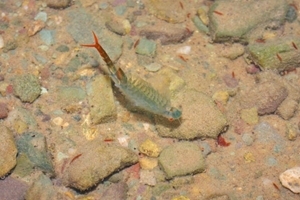Fairy shrimp
 At this time of year, when thoughts start to turn towards Christmas, familiar old boxes containing decorations will be dug out and the hunt for the all-important fairy will start. The fairy will, of course, eventually sit in pride of place at the top of the tree, looking down on all of the excitable proceedings taking place below!
At this time of year, when thoughts start to turn towards Christmas, familiar old boxes containing decorations will be dug out and the hunt for the all-important fairy will start. The fairy will, of course, eventually sit in pride of place at the top of the tree, looking down on all of the excitable proceedings taking place below!
But this is not the only fairy that can be searched for, as other ‘real’ fairies put in an appearance at this time of year, not high up on a tree, but swimming around in shallow, rain-filled pools.
The remarkable little fairy shrimp (Chirocephalus diaphanous), which at its full adult size only registers a length of 3cm long, can hatch within 48 hours of a pond filling and, under ideal conditions, will begin to breed within three weeks.
Fairy shrimp have an extremely quick life-cycle and they need to, as they choose very specific places to breed. The important fact about the water areas that fairy shrimps choose to bred is that they will at some point dry out during the year. These temporary water bodies never become colonised by fish or other predators that would, of course, soon munch up such small, vulnerable prey.
Once the adults hatch out, males will latch on to females with their ‘claspers’, fertilising the eggs. Females then carry the fertilised eggs, which can vary in number from 10 to 150, in an egg sac just beneath her thorax for several days, before releasing them to sink to the bottom of the pool.
Now, here is the clever bit! The eggs are able to survive quite happily when the pond dries out, as they simply lie dormant until the next substantial re-wetting event fills up the area with water once again. However, not all the eggs will hatch out when the rain arrives, as some eggs will remain in a dormant state, so that if conditions deteriorate and the pond dries out too quickly to allow for a successful breeding attempt, some eggs will survive to try their luck at a later date.
Although the normal period of egg dormancy is usually between 6 to 10 months, eggs have been hatched in a laboratory after a period of 15 years!
Fairy shrimps are translucent, meaning that light passes through their bodies, and they have red tips to their abdomen. They lack a carapace, a body-covering shell, that other shrimps have. They swim on their back, with their head curving downward, using 11 pairs of leaf-like legs fringed with bristles that are constantly moving. They have two black-stalked eyes and two pairs of antennae; the second pair in the males are modified ‘claspers’ to latch on to females during mating.
The two stronghold areas for fairy shrimps are Hampshire’s New Forest and Wiltshire’s Salisbury Plain, but they can also be found on the edge of Dartmoor in Devon and in parts of the Sussex Weald, as well as in Oxfordshire, East Anglia and South Wales. Their northern limit is around the Humber estuary across to northern Wales.
The Salisbury Plain fairies have an interesting relationship with the army. Shells blasts create craters and huge, rumbling tanks leave behind massive ruts, both of which fill up with water, forming the ideal habitat for these delicate little creatures. In fact, it has been shown that the eggs can be transported around by tanks, contained in the mud on the tank tracks – a distributing job that would normally have been done by deer or cattle in the past!
The best time to search for shrimps is about four weeks or so after the area has refilled with water. So it might well mean that during this year’s Christmas Day walk, you suggest that everyone goes on a fairy hunt – that should tear the children away from their new toys!
Fairy shrimps are classified as vulnerable in the British Red Data Book, meaning that it is fully protected in the UK under Schedule 5 of the Wildlife and Countryside Act 1981 and listed as a Species of Conservation Concern under the UK Biodiversity Action Plan, although not a priority species. So just look at them and don’t catch them!
Photo credit: Alexander Mrkvicka